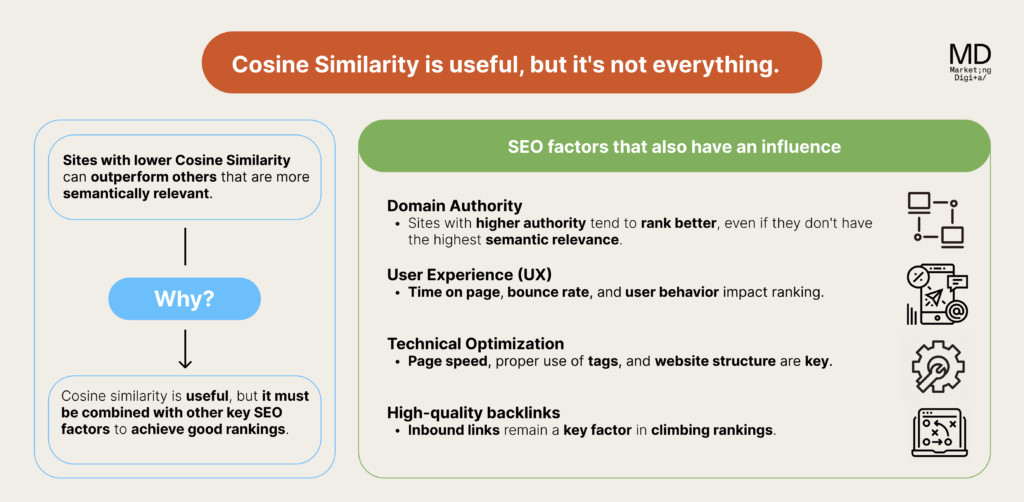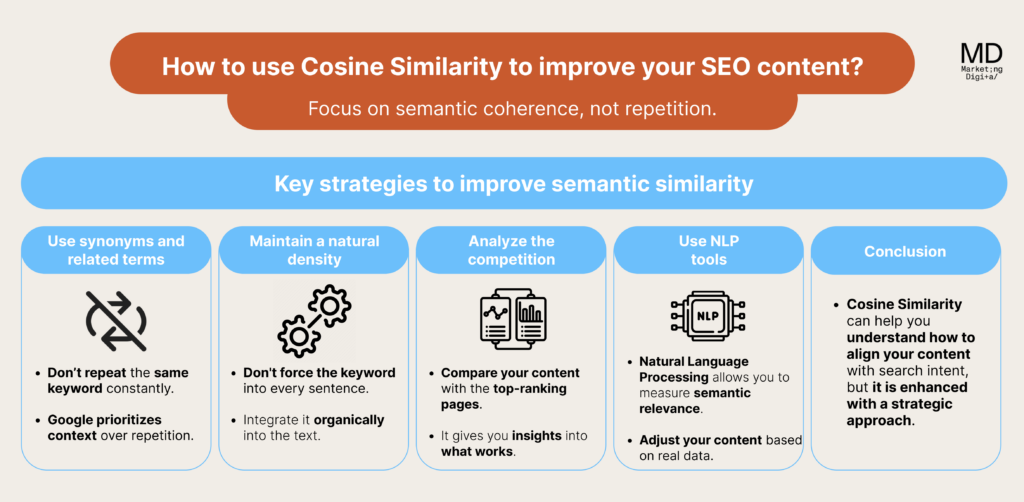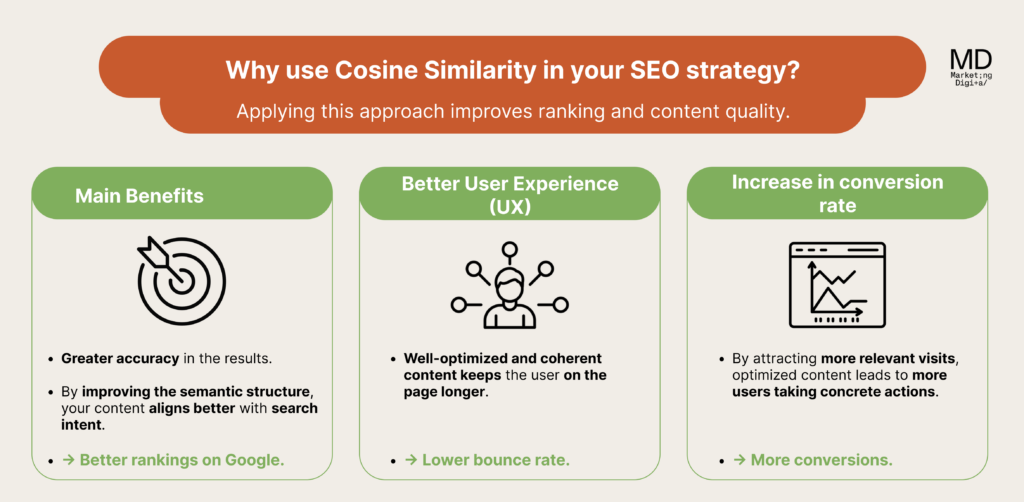Search engines, especially Google, have evolved significantly in how they interpret content. It’s no longer just about repeating keywords, but about understanding how the content relates to user intent. This is where cosine similarity, or Cosine Similarity, comes into play—a mathematical technique that measures the similarity between two texts and helps determine whether content is truly aligned with a specific keyword or topic.
Although Cosine Similarity can be a useful tool for improving semantic relevance and organic ranking, its exact impact on Google’s algorithms is not publicly documented. Therefore, while it is likely to contribute to overall optimization, it cannot be guaranteed to be the determining factor in a website’s relevance and ranking.
What is cosine similarity?

Cosine similarity is a metric used to measure how similar two texts, documents, or data sets are, regardless of their size. Instead of comparing the content word by word, this technique converts each text into a numerical vector and then measures the angle between those vectors.
The logic is simple:
- If two vectors point in the same direction, the angle between them is close to 0, and the cosine similarity approaches 1 (i.e., they are very similar).
- If the vectors are perpendicular, the cosine will be 0, indicating no semantic relationship.
This technique is widely used in recommendation systems, plagiarism detection, search engines, and, in this case, semantic SEO.
Simple example:
Let’s imagine two texts:
- Text A: “digital marketing for SMEs”
- Text B: “online advertising for small businesses”
Although they don’t share exact words, a good vector model can detect that both deal with similar topics and calculate a high cosine similarity between them.
Cosine Similarity and Semantic SEO: The New Paradigm
In modern SEO, Google no just analyzes exact words anymore, but entire contexts. The algorithm aims to understand whether the content responds naturally and comprehensively to a query. This is where Cosine Similarity comes in: by quantifying the semantic relationship between a keyword and a text, we can measure whether Google would also consider it relevant.
Cosine Similarity is not the only key factor for SEO

While Cosine Similarity is a useful metric for evaluating the semantic relevance of content, it is not the only factor that determines search engine rankings. In fact, in many cases, we can find websites with lower cosine similarity scores outperforming others with higher scores in search results. This is because Google uses a combination of additional factors, such as:
- Domain authority: Sites with higher authority tend to rank better, even if their content is not the most semantically relevant.
- User experience (UX): Metrics like time on page, bounce rate, and other user experience indicators influence rankings.
- Technical optimization: Factors such as loading speed, use of meta tags, and website structure can significantly impact SEO.
- Inbound links (backlinks): A site with a strong profile of quality backlinks can rank higher even if its content isn’t as semantically aligned with the keyword.
Therefore, although Cosine Similarity is a powerful tool for assessing the semantic relationship between content and a keyword, it should be used alongside other SEO strategies to achieve the best results.
How to Apply Cosine Similarity in SEO Content

To improve our content’s ranking, we need to maintain semantic coherence with key terms. Some key strategies include:
- Varying keywords: Use synonyms and related terms instead of repeating the same keyword. Google values context more than excessive repetition.
- Natural keyword density: It’s not about inserting the main keyword into every sentence, but about distributing it naturally throughout the content.
- Competitor analysis: Comparing your content with top-ranking pages can provide insights into improvements and opportunities.
- NLP tools (Natural Language Processing): Advanced tools can help measure semantic relevance and adjust content to enhance optimization.
How to Measure a Page’s Relevance with Cosine Similarity?
To evaluate the relevance of content in relation to a keyword, we can use the following Python script. This tool extracts the text from a web page and compares it with a specific keyword using Cosine Similarity:

Benefits of Applying Cosine Similarity in Your SEO Strategy
Implementing this approach offers significant advantages:
- Greater accuracy in search results: Better-structured, semantically optimized content improves its ranking on Google.
- Enhanced user experience: Well-crafted content not only attracts traffic but also keeps users on the page longer.
- Increased conversions: Optimized content not only drives traffic but also boosts conversion rates by attracting genuinely interested visitors.

Frequently Asked Questions
How is semantic similarity calculated in SEO?
It can be calculated using NLP techniques such as TF-IDF vectorization and the Cosine Similarity formula, which compares the angle between two text vectors.
What is a good cosine similarity score?
In general, a value above 0.75 indicates high semantic relevance between the keyword and the content.
Conclusion
Using Cosine Similarity in SEO helps improve the quality and relevance of content, leading to better search engine rankings. However, it is just one piece of the SEO puzzle. To achieve optimal positioning, it’s essential to combine this technique with other key factors such as domain authority, user experience, and a comprehensive optimization strategy.
If you’re optimizing your site and want to ensure maximum semantic relevance of your content, explore NLP tools or implement this script in your audits. Measure, improve, and rank better.
¿Qué te pareció este artículo?
What do you think about this post?



